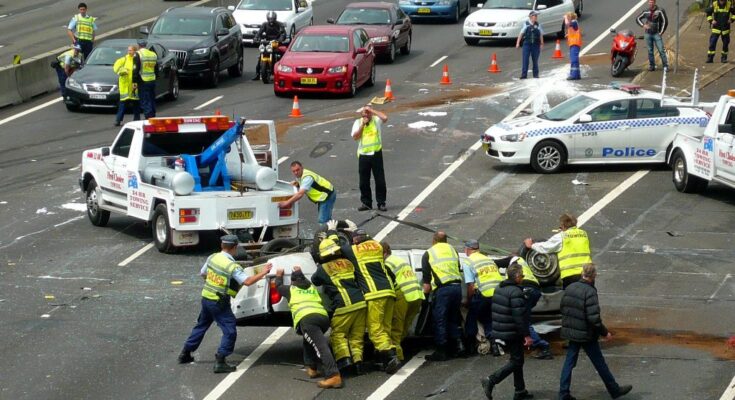Wes Marshall calls attention to a paradox about the profession in which he began his career:
“It would make sense to assume that newer cities, built with all the knowledge that traffic engineers continue to accumulate, should be our safest cities. But that is not the case. It’s the older cities—mostly built before traffic engineers existed— that tend to be safer.” (Killed by a Traffic Engineer, p 202)
Elsewhere in the pages of his new book, Marshall notes that the paradox extends to areas within cities as well: “Streets built before the advent of traffic engineers are some of our safest, often with far fewer fatalities and severe injuries than the new-and-improved, fully traffic-engineered versions.” ( p 257)

Killed By A Traffic Engineer, by Wes Marshall, Island Press 2024.
Marshall is now a professor of civil engineering and urban planning at the University of Colorado Denver. He distills 25 years of learning into Killed By a Traffic Engineer: Shattering the Delusion that Science Underlies our Transportation System. (Island Press, April 2024) While he would like to see his profession become an agent for sustainability, safety, and conviviality, that will require a radical transformation of goals and methods.
The book is an extended take-down of the idea that the voluminous design guidelines, published by groups such as the American Association of State Highway and Transportation Officials (AASHTO), provide evidence-based formulas for safe roads and streets.
Marshall argues that in fact these guidelines, far from prioritizing safety, put traffic volume and speed first. To the extent that safety is considered, he says, safety is typically viewed from the perspective of the drivers, and not those outside cars or trucks. Finally, he demonstrates through extensive historical research that many of the engineers who worked with or developed the guidelines over the past 70 years were aware that supporting evidence was lacking or fragmentary.
Given the above summary, readers interested in transportation systems and planning might wonder if Marshall’s book largely repeats points made by Charles Marohn in his excellent book Confessions of a Recovering Engineer. (Wiley, 2021)
There is some overlap and the messages of the two books are strongly complementary. Yet Marshall includes so much relevant detail, and such insightful probing of engineering and safety research, that Killed By A Traffic Engineer is worth every minute invested in reading its 344 pages, even for those who have already read Marohn’s work.
Marshall’s focus is almost solely on traffic engineering practice in the United States, but residents of car-dependent areas in other countries are likely to find a great deal of relevance in the book.
In this review we’ll look at a few of the major topics Marshall covers.
First, there is the poor quality of evidence, and frequent misapplication of that evidence, underlying many traffic engineering guidelines. Second, the “factor of safety” used successfully in structural engineering often has contrary consequences in fields that, like traffic engineering, should account for human behaviour. Finally, using per-vehicle-mile safety metrics, instead of per capita metrics, blinds us to the true danger of a society in which driving substantial distances is an obligatory daily ritual for most people.
What didn’t they know, and when didn’t they know it?
A nascent field of study got its own scholarly journal when the Eno Foundation began publishing the Traffic Quarterly in 1947. The journal, which was later renamed Transportation Quarterly, continued until 2003 – and it appears that Marshall has read every article in every issue.
Rather than simply assume that the current massive tomes of road and street guidelines are based on extensive safety research, Marshall quotes many Quarterly articles to establish the contrary.
An important case of misapplied data was passed down as Heinrich’s Law, or the “accident triangle”. In 1931, Travelers Insurance employee H.W. Heinrich examined some data on industrial accidents. He determined that “In a workplace, for every accident that causes a major injury, there are 29 accidents that cause minor injuries and 300 accidents that cause no injuries.” (quoted by Marshall, page 94)
Would this same relationship apply in other settings or in other time periods? Who knows? Yet it became widely accepted among traffic engineers that a similar proportional relationship would exist between very serious crashes, moderately serious crashes, and crashes resulting in only minor dents or scratches to cars.
If a steady, proportional relationship existed between accidents of differing severity, then it would follow that by reducing all accidents of any sort, we would reduce the serious accidents that maim or kill people.
This fixed proportional relationship was an illusion, but it was often a convenient illusion. Particularly when comparing the crash rates of specific locations, data on serious accidents might be too sparse to drawn any inferences. Aggregating all crashes, however, might seem to provide an adequate number of data points.
As Marshall points out, this methodology cast a harsh light on downtown areas. Such typically congested areas often have a relatively high number of crashes. But since speeds are low, most of the crashes will be fender-benders.
Higher-speed arterials may have few fender-benders, but more serious injuries or fatalities.
An analyst working on the assumption that the total number of crashes was a reliable proxy for serious crashes would label the downtown locations “more dangerous” and the arterial roads “less dangerous”. This line of thinking led traffic engineers, more than sixty years ago, to try to improve safety by lessening congestion. Marshall writes:
“For much of the history of traffic engineering, we considered traffic congestion to be a proxy for road safety. As our good friends over at AASHO1 inform us in their 1957 manual on urban arterials, ‘Congestion breeds accidents.’” (p. 99)
Marshall highlights weaknesses in available data sets in other respects as well. He writes that the best accident data for the whole US is the Fatality Analysis Reporting System (FARS). The FARS reports contributing causes, but unless there are eyewitnesses or surveillance footage, the police often have no reliable way to determine something as basic as the speed the driver was driving. This results in a set of statistics that stretches credulity:
“Over a recent six-year period, 28,642 pedestrians lost their lives on streets with a posted speed limit. How many of the drivers who killed these 28,642 pedestrians were speeding? According to FARS, the answer is 2,015.
“Go look at almost any road. Does it seem within the realm of possibility that the speeding problem is limited to 7 percent of drivers? Of course not ….” (p 236)
Suppose the fatal crash report does include speeding as a contributing cause. It is all too easy to conclude “case closed”: the driver was to blame for speeding. But how much sense does this make, in a system where most roads are designed to facilitate speeds higher than the speed limit, where cars are marketed with the promise of exhilarating and consequence-free speed, where law enforcement seldom tickets drivers who are driving modestly above the supposed maximum legal speed, and where most drivers speed whenever the roads are free enough of congestion to allow this? Is it really sensible, in such a system, to simply blame the driver for speeding in those cases where an accident results, when the driver is doing what nearly all drivers routinely do?
Even more to the point, Marshall argues, traffic engineers will only contribute to safety when they stop focusing on the after-the-fact blaming of individual drivers, and work instead to design roads where speeding is not the predictable and average behaviour.2
Why a margin of safety may increase danger
Civil engineers, Marshall writes, typically receive much more instruction in structural engineering than in traffic engineering. But some eminently logical practices in structural engineering do not transfer well to traffic engineering.
An engineer designing a bridge support might calculate the strength needed to support the maximum expected weight, and then double the size of the pillar to add a “factor of safety”. An engineer designing a culvert might estimate maximum water flow, and then double the size of the culvert to add a factor of safety.
The double-strength pillar does not induce heavier trucks to cross the bridge, and the double-size culvert does not induce more rain to fall, so the factors of safety hold true.
But suppose traffic engineers work in the same fashion. Starting from the specified design speed and the estimated traffic volume, they consult the guidelines and sketch a roadway with a certain number of lanes of a certain width, with a certain amount of space beside the road that is cleared of any obstacles such as trees or parked cars. Then, to create a factor of safety, they might increase the width of the lanes, add a lane or two, and increase the amount of clear space beside the road.
In this case the factor of safety is counter-productive. The extra lane(s) induce more traffic to travel on the newly widened road, while the wider lanes and wider visual clear space result in drivers speeding up. With more traffic traveling at higher speeds, the risk of serious injury or fatalities is increased, not decreased, by the “factor of safety”.
“Multi vehicle accident – M4 Motorway, Sydney, NSW, October 2012, photo by sv1ambo, from Wikimedia Commons.
The fatal flaw in “per vehicle mile” safety metrics
Traffic safety is often quantified using a per-vehicle-mile, or per-million-vehicle-mile, ratio. This has serious consequences. Marshall writes,
“Conventionally, distance traveled is the denominator in our crash rates. The number of crashes, injuries, or deaths on our roads is the numerator. You’d think that focusing on reducing the numerator so as to improve crash rates makes the most sense. The problem is that we’ve instead focused on increasing the denominator. In other words, given the way we measure road safety, we all seem safer if we all drive a lot more. We built places that force us to do so. Crashes go up a little, but we drive a lot more, so we’re convinced we improved safety.” (p 356)
Marshall supports his point with both a hypothetical example and with real-world data.
He asks us to consider the fictional towns of Driveton and Heresville. They each have lost 150 citizens in traffic crashes over the past 10 years. Does that make them equally safe?
Well, the average citizen of Driveton drives 25,000 miles per year, while citizens of Heresville only average 5,000 miles per year. Driveton’s fatality rate is 1.2 deaths per 100 million vehicle miles – approximately the US average – while the fatality rate in Heresville is 1.5 deaths per 100 million vehicle miles. If vehicle miles is the denominator, then Heresville is 25 per cent more dangerous than Driveton.
But consider one more important piece of data. Driveton has 50,000 people, while Heresville has 200,000. But they have the same number of annual fatalities. A citizen of Driveton has four times as much chance of dying in a traffic crash as a citizen of Heresville. And yet, Marshall writes, “conventional traffic engineering metrics tell us that Driveton is safer.” (p 85)
Using a per capita metric, rather than a per vehicle mile metric, tells us something crucially important about car-dependent mobility systems.
Marshall looked at 24 years of data from the US Fatality Analysis Reporting System. This data set includes the zip code of the drivers, and population density data is also available for each zip code. After grouping zip codes into twelve categories ranked from highest to lowest population density, Marshall writes,
“What I found is that those living in the most urban places in the United States experience safety outcomes on par with the safest countries in the world. It gets worse and worse at every step in between until you reach the most rural places, which are on par with the most dangerous countries in the world. The difference? In the United States, you are six times more likely to die on the roads if you live in the most rural areas than in the most urban.” (p 92)
When we use a population metric, rather than a vehicle mile ethic, it’s clear that traffic violence is a greater risk to people who live in more car-dependent areas.
“One of the greatest barriers to road safety is having to drive everywhere, all the time, even for the simplest errand,” Marshall concludes. “More specifically, the greatest barriers to road safety are the places we’ve built that force people to drive everywhere, all the time, even for the simplest errand.” (p 356)
Traffic engineers have aided and abetted that car-dependency, by prioritizing vehicle capacity, speed and throughput on our roads and streets. Making safety the priority – that is, shrinking the per capita rate of traffic deaths and injuries – will require new ways of thinking. Traffic engineers will need to think about why public transit is a non-existent or unattractive option for so many people, and what they can do to help make good transit possible. Traffic engineers will need to plan streets that are safe for children to cross without worried adults hovering around them. Traffic engineers will need to plan streets that people with reduced physical ability can cross safely, and without going hundreds of meters out of their way. Traffic engineers will need to co-ordinate with urban planners to promote neighbourhoods where residents can routinely go shopping, go to school or work, and meet and visit with friends without getting into cars.
Traffic engineers will need to focus more on accessibility, and less on mobility.3
As Lewis Mumford wrote in 1963, in one of Marshall’s favourite quotes, “A good transportation system minimizes unnecessary transportation.”4




